Going with the new biannual release cycle of my Swing projects, it’s time to do the release candidates for the latest iterations of Substance and Flamingo.
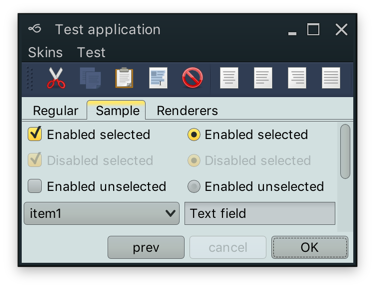
Along with a few visual polishes and tweaks, Substance 7.1 (code-named Vermont) brings support for using correct default system font on macOS 10.10+ when you’re running your app under the recently-released Java 9.
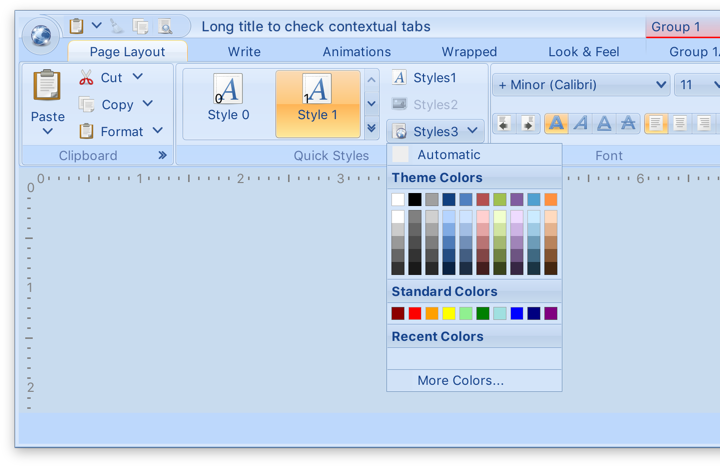
The previous release of Substance brought full support for high DPI screens, and the latest release candidate for Flamingo 5.2 (code-named Kennocha) aligns both libraries to be first class citizens on modern screen hardware. The unofficial release notes are:
- Full high DPI support for all components, including
- Command button icons and arrows
- Color selector popup menu
- Ribbon galleries
- Ribbon bands in collapsed state
- Support for vertical scrolling of secondary level content in ribbon application menu
- Better mouse wheel handling in command menu popups
- Addressed clipping issues on some transcoded SVG content
If you’re in the business of writing Swing desktop applications, I’d love for you to take the latest release candidates of Substance and Flamingo for a spin. You can find the downloads in the /drop folders of the matching Github repositories. All of them require Java 8 to build and run. The final releases are scheduled to happen in two weeks’ time, on the week of October 16th.
Back in the olden days of 1999 it was pretty much the only movie that I watched in the theaters. In pre-digital days it took a few months for a movie to complete its theatrical rollout across the globe, and once it got into theaters, it stayed for much longer than it does these days. Such was the story of “The Matrix” for me. It stayed in local theaters for at least six months, and I was a single guy with not much to do in the evening after work. So every week, at least twice a week, I would go to watch it again. And again. And again. It’s quite unlikely, in fact, that there’s ever going to be a movie that I’ll watch more times than I’ve watched “The Matrix”.
Back in those olden days, people didn’t wake up to write a new Javascript library. People woke up to write a Matrix rain screensaver. Those would be the mirrored half-width kanas, as well as Latin characters and arabic numerals.
A few years later, “Matrix: Reloaded” came out, taking the binary rain into the third dimension as the glyphs were sliding down multiple virtual sheets of glass. And I finally decided to dip my toes into the world of making my own Matrix rain screensaver, complete with many of the visual effects that were seen in that movie. There’s a bunch of old code that I’ve uploaded as an historical artifact right here. Fair warning – this was 13 years ago, and as many do when they first start out, I reimplemented a bunch of stuff that was already there in the JDK. If you dive into the code, you’ll see a home grown implementation of a linked list, as well as a rather gnarly monstrosity that exposed something that resembled a canvas / graphics API. Don’t judge me. Anyhoo, on to the topic of this post.
One of the things I’ve wanted to do in that screensaver was to take a string as input and render it in the style of Matrix titles:

In here, every glyph undergoes one or more transformations (cropping, displacement, segment duplication). In addition, there are connectors that link glyphs together. It is these connectors that I’m going to talk about. Or, more precisely, how can you come up with the “best” way to connect the glyphs of any input string, and what makes a particular connector chain the “best” chain for that string?

This image captures the “essence” of quantifying the quality of a connector. In the title sequence of the original movie, as well as the sequels, the connectors are only placed at three vertical positions – top, middle and bottom. That is the starting point of this diagram. In addition, there are the following factors at the level of an individual glyph:
- On the scale from 1 to 5, how far the connector would have to go “into” the glyph to connect to the closest pixel? So, the bottom part of A gets 5’s on both sides, and the top part gets 2’s on both sides. The middle part of J gets 0 on the left (as the connector would have to “travel” across the entire glyph) and 4 on the right (as the connector would need to go past the rightmost point of the top serif).
- Defining a “natural” connection point to be (in the diagram above green marks such a point while red signifies that the point is not natural):
- Anything on top and bottom – this is an escape valve that would make sure that any input string has at least one connector chain
- Serifs in the middle – such as the right side of G
- Crossbars in the middle, extending to both sides of the glyph – such as A, B or R.
Then, a valid connector chain would be defined as:
- No two consecutive connectors can be placed at the same vertical position. In the example of the original title, the connector chain is top-bottom-middle-bottom-top.
- A connector must have positive (non-zero) value on both sides. For example, you can’t connect A and J in the middle because the left side of J places value 0 on the middle position.
- A connector must have at least one natural connection point. For example, N and O can’t be connected in the middle, while N and P can (as P’s left side defines the middle position as a natural connection point)
Finally, the overall “quality” of the entire connector chain is computed as:
- The sum of connection point values along both sides of each connector
- Weighed by the chi-square value of the connector vertical positions along the entire chain
- Weighed by the mean probability of the connector vertical positions along the entire chain
The last two factors aim to “favor” chains that look “random”. For example, there is not much randomness in a top-bottom-top-bottom-top-bottom chain. You want to have a bit of variety and “noise” in a chain so that it doesn’t look explicitly constructed, so to speak. As can be seen in the diagram above, the middle vertical position is not a natural connection point for a lot of glyphs, and both of these factors aim to bring a well-distributed usage of all vertical position into the mix.
It is true that the basic underlying rules of defining how a glyph connector chain is constructed are based on the visuals of the Matrix movie titles. You might think of this as the basic rules of physics that apply to the particular universe. However, the evaluation of a specific constructed chain is a softer framework, so to speak. There is nothing explicit in these rules that would force the quality score of the particular connector chain that you see in the final graphics for these particular six letters to be the highest of all valid chains.

When I first ran the finished implementation, it was one of those rare moments of pure, unadulterated geek joy:

These are all possible valid connector chains for the word “MATRIX”, ordered by the quality score that is based on values of individual connector points, as well as statistical variation that accounts for predictability and randomization within a specific sequence. Yes, the top score goes to the sequence that was used in the movie title!
Let’s look at “RELOADED” next:

And these are the top 39 valid connector chains for that word:

While my algorithm found the perfect match for “MATRIX” connector chain, the connector chain that was used in the movie for “RELOADED” is scored at place #37. You can see where it falls flat – in the top connector between L and O. The score value for top connector on the right side of L is 1 out of 5, and while the score value for top connector on the left side of O is 5 out of 5, that drastically lowers the overall score. In addition, the last four connectors are bottom-middle-bottom-middle which lowers the median probability factor applied to the entire quality score of this chain.

The connector chain selected by the third movie for the word “REVOLUTIONS” is not considered a valid one based on the rules that I chose after “Reloaded” was out. Specifically, the middle connector between U and T is not valid, as there is neither a serif not a crossbar in these two glyphs. And the same applies to the middle connector between I and O.

Finally, the “ANIMATRIX” title deviates slightly in the “MATRIX” part, using middle connector placement between M and A. How did my algorithm fair on scoring this chain?

This was a close one. The connector chain used in the movie title scores at the second place, with the only difference being in the very first connector (top instead of middle).
It’s hard to quantify artistic choices, and I don’t presume to claim that the top-scored connector chain for “RELOADED” based on the rules of my algorithm is clearly superior to what ended up in the actual movie titles. Would it be worth to tweak the scoring system? I don’t think so. There are a couple of noticeable “weak” connectors in the connector chain in the movie title, and relaxing the scoring rules would only introduce more randomness into the process without necessarily bumping up that chain up the ranks.
Perhaps the artistic choice of choosing a long top L to O connector was based on introducing a bit of variance and randomness into the mix. Or perhaps I should check to see who was in charge of the title graphics and ask them :)
Today is the day a bunch of my long-running Swing projects get officially back to life. If you’ve missed the previous post from late last year, those of you who are still in business of writing Swing applications might be interested to take a look at the latest releases of Substance, Flamingo and Trident.
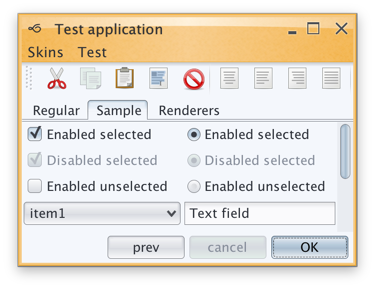
Substance is a versatile, extensible and fast look-and-feel that brings a wide variety of lovingly tailored skins, as well as quite a few behavior augmentations to Swing applications. The major themes of release 7.0 (code-named Uruguay) are support for high DPI monitors, reduction of visual noise and improved visual consistency across all core skins.
Substance 7.0 also has three new skins. The first one is Cerulean skin which was part of the Insubstantial fork that was maintained by Danno Ferrin:
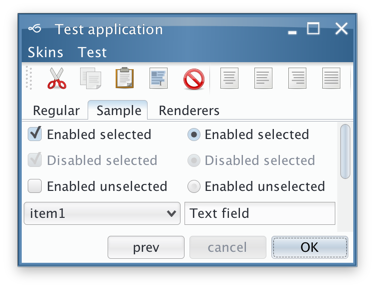
The other two were added to the Graphite family. The first one is Graphite Gold that uses gold highlights on active elements:

The second is Graphite Chalk that has increased contrast on all UI elements:
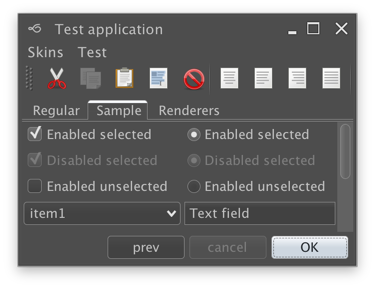
Flamingo is a component suite that provides a Swing implementation of the Office 2007 ribbon container and related components. All Flamingo components have been streamlined to look well under Substance skins, including full high DPI support. Flamingo’s latest release is 5.1 code-named Jileen:

Finally, Trident is the animation library that powers all the animation in both Substance and Flamingo. As this library does not have any user-facing features that directly touch pixels, there is no new functionality in this release. Much has changed since the last time I’ve worked on Trident, and the time has come to remove built-in support for both SWT and Android. With release 1.4 (code-named Enchanted) Swing is the only UI toolkit supported out of the box.
What is next for these libraries?
As the title of this post suggests, I am planning to do two releases a year. What is on that roadmap? I’m not going to make any strong commitments, but these are the rough areas for the next few releases:
- There once was time where I’ve hoped that other look-and-feels would adopt some of the pieces of Substance. That time is long gone, and splitting the functionality across multiple pieces is just overhead. The relevant functionality from both laf-plugin and laf-widget projects is going to be folded back into the Substance code base.
- It is highly likely that I’m going to move Substance away from “seamless” discovery of plugins based on classloader magic. For example, if you’re using Flamingo in your application, you will need to declare an explicit plugin initialization along with setting Substance as your look-and-feel.
- Speaking of Flamingo, I’m going to focus exclusively on how those components look and behave under Substance. Third party look-and-feels are not what they used to be. It’s just not worth my time any more.
- Having said that, there’s much work to be done in Flamingo to provide full support for high DPI monitors. This is the place to follow that work.
So, if you still find yourself writing Swing applications, I’d love for you to give the latest release wave a try. You can find the downloads in the /drop folder of the matching Github repositories. All of them require Java 8 to build and run.
![]()
![]()